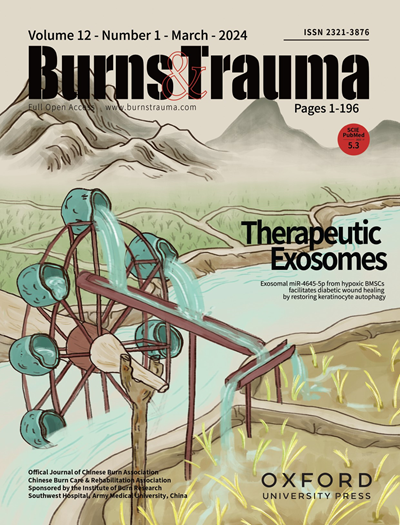1H 核磁共振分析揭示了严重烧伤患者代谢特征的动态变化
IF 6.3
1区 医学
Q1 DERMATOLOGY
引用次数: 0
摘要
背景 严重烧伤会引起高代谢反应,导致肌肉蛋白质分解和多器官损伤综合征。然而,这种反应尚未通过代谢组学对患者进行持续的表征。本研究旨在量化严重烧伤患者代谢过程的时间变化。方法 我们采用 1H-核磁共振(NMR)光谱仔细研究了 17 名成年重度烧伤患者烧伤后最初 35 天内的代谢变化,并将 10 名健康人作为对照组。研究人员在烧伤后第 1、3、7、14、21、28 和 35 天采集了患者的血浆样本。在进行多变量统计分析、重复测量方差分析和时间序列分析后,我们对代谢物浓度的变化进行了量化。结果 在 119 份烧伤患者样本中量化的 36 种代谢物中,支链氨基酸、谷氨酸、甘氨酸、葡萄糖、丙酮酸、乳酸、三甲胺 N-氧化物和其他代谢物的浓度表现出明显的时间变化。值得注意的是,这些代谢物可根据其时间特征分为三类。损伤初期反应的特点是乳酸和氨基酸的变化,而后期的变化则是脂肪酸分解代谢和微生物代谢的增加,导致酮体和微生物代谢物的积累。结论 利用核磁共振的代谢组学技术有可能监测严重烧伤患者复杂的新陈代谢过程。本研究证实,烧伤后第三天是退潮期和流动期的分界线。此外,对代谢物三种不同时间模式的鉴定揭示了这些代谢物之间内在的时间关系,为优化治疗策略提供了临床数据。本文章由计算机程序翻译,如有差异,请以英文原文为准。
1H-nuclear magnetic resonance analysis reveals dynamic changes in the metabolic profile of patients with severe burns
Background Severe burn injury causes a hypermetabolic response, resulting in muscle protein catabolism and multiple organ damage syndrome. However, this response has not yet been continuously characterized by metabolomics in patients. This study aims to quantify temporal changes in the metabolic processes of patients with severe burns. Methods We employed 1H-nuclear magnetic resonance (NMR) spectroscopy to scrutinize metabolic alterations during the initial 35 days following burn injury in a cohort of 17 adult patients with severe burns, with 10 healthy individuals included as controls. Plasma specimens were collected from patients on postburn days 1, 3, 7, 14, 21, 28 and 35. After performing multivariate statistical analysis, repeated-measures analysis of variance and time-series analysis, we quantified changes in metabolite concentrations. Results Among the 36 metabolites quantified across 119 samples from burn patients, branched-chain amino acids, glutamate, glycine, glucose, pyruvate, lactate, trimethylamine N-oxide and others exhibited obvious temporal variations in concentration. Notably, these metabolites could be categorized into three clusters based on their temporal characteristics. The initial response to injury was characterized by changes in lactate and amino acids, while later changes were driven by an increase in fatty acid catabolism and microbial metabolism, leading to the accumulation of ketone bodies and microbial metabolites. Conclusions Metabolomics techniques utilizing NMR have the potential to monitor the intricate processes of metabolism in patients with severe burns. This study confirmed that the third day after burn injury serves as the boundary between the ebb phase and the flow phase. Furthermore, identification of three distinct temporal patterns of metabolites revealed the intrinsic temporal relationships between these metabolites, providing clinical data for optimizing therapeutic strategies.
求助全文
通过发布文献求助,成功后即可免费获取论文全文。
去求助
来源期刊

Burns & Trauma
医学-皮肤病学
CiteScore
8.40
自引率
9.40%
发文量
186
审稿时长
6 weeks
期刊介绍:
The first open access journal in the field of burns and trauma injury in the Asia-Pacific region, Burns & Trauma publishes the latest developments in basic, clinical and translational research in the field. With a special focus on prevention, clinical treatment and basic research, the journal welcomes submissions in various aspects of biomaterials, tissue engineering, stem cells, critical care, immunobiology, skin transplantation, and the prevention and regeneration of burns and trauma injuries. With an expert Editorial Board and a team of dedicated scientific editors, the journal enjoys a large readership and is supported by Southwest Hospital, which covers authors'' article processing charges.
 求助内容:
求助内容: 应助结果提醒方式:
应助结果提醒方式:


